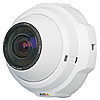Axis Communications 212 PTZ 212 PTZ/-V - User's Manual - Page 37
Ports & Devices, LED, AXIS 212 PTZ/-V - System Options, UPnP™, Bonjour
 |
View all Axis Communications 212 PTZ manuals
Add to My Manuals
Save this manual to your list of manuals |
Page 37 highlights
AXIS 212 PTZ/-V - System Options Traps for SNMP v1/v2 Traps are used by the camera to send messages to a management system for important events or status changes. Select Enable traps to activate trap reporting. Enter the email address the trap message is to be sent to, and specify the Trap community that should receive the message. There are four types of traps available for the network camera. • Cold start • Warm start • Link up • Authentication failed SNMP V3 - provides encryption and secure passwords. HTTPS must be enabled. To use traps with SNMP v3 an SNMP v3 management application is required. If the Enable SNMP v3 option is enabled, provide the Initial user password. Note that the initial password is activated only when HTTPS is enabled and can only be set once. If HTTPS is enabled, SNMP v1 and SNMP v2c should be disabled. When SNMP configuration is ready, click Save to use the new settings or Reset to return to the default values. UPnP™ The camera includes support for UPnP™, which is enabled by default. If also enabled on your computer, the camera will automatically be detected and a new icon will be added to "My Network Places." Note: UPnP must also be enabled on your Windows XP. To do this, open the Control Panel from the Start Menu and select Add/Remove Programs. Select Add/Remove Windows Components and open the Networking Services section. Click Details and then select UPnP as the service to add. RTP These settings are the port range, IP address, port number (video and audio), and Time-To-Live value to use for the video stream(s) in multicast MPEG-4 format. Only certain IP addresses and port numbers should be used for multicast streams. For more information, please see the online help. Bonjour AXIS 212 PTZ/-V includes support for Bonjour. When enabled, the camera is automatically detected by operating systems and clients that support Bonjour. Ports & Devices I/O Ports - the pinout, interface support and the control and monitoring functions provided by this connector are described in The I/O Terminal Connector, on page 40. LED The Status indicator LED on the front of the camera can be set to flash at a configurable interval (or to not light up at all) whenever the unit is accessed. For a listing of all LED behavior, see page 7, or the online help. Note that the LED does not flash when the stream is retrieved using MPEG-4 multicast. 37















